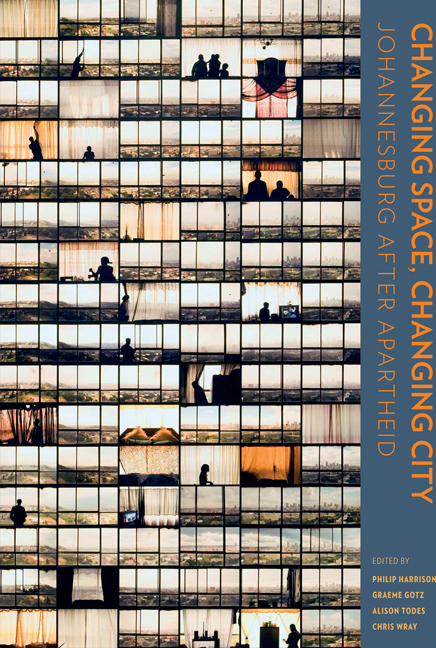Book contents
- Frontmatter
- Contents
- Preface
- Cartography
- 1 Materialities, subjectivities and spatial transformation in Johannesburg
- Section A The macro trends
- Section B Area-based transformations
- Section C Spatial identities
- 23 Footprints of Islam in Johannesburg
- 24 Being an immigrant and facing uncertainty in Johannesburg: The case of Somalis
- 25 On ‘spaces of hope’: Exploring Hillbrow's discursive credoscapes
- 26 The Central Methodist Church
- 27 The Ethiopian Quarter
- 28 Urban collage: Yeoville
- 29 Phantoms of the past, spectres of the present: Chinese space in Johannesburg
- 30 The notice
- 31 Inner-city street traders: Legality and spatial practice
- 32 Waste pickers/informal recyclers
- 33 The fear of others: Responses to crime and urban transformation in Johannesburg
- 34 Black urban, black research: Why understanding space and identity in South Africa still matters
- Contributors
- Photographic credits
- Acronyms
- List of plates
- List of figures
- List of tables
- Index
26 - The Central Methodist Church
from Section C - Spatial identities
Published online by Cambridge University Press: 20 April 2018
- Frontmatter
- Contents
- Preface
- Cartography
- 1 Materialities, subjectivities and spatial transformation in Johannesburg
- Section A The macro trends
- Section B Area-based transformations
- Section C Spatial identities
- 23 Footprints of Islam in Johannesburg
- 24 Being an immigrant and facing uncertainty in Johannesburg: The case of Somalis
- 25 On ‘spaces of hope’: Exploring Hillbrow's discursive credoscapes
- 26 The Central Methodist Church
- 27 The Ethiopian Quarter
- 28 Urban collage: Yeoville
- 29 Phantoms of the past, spectres of the present: Chinese space in Johannesburg
- 30 The notice
- 31 Inner-city street traders: Legality and spatial practice
- 32 Waste pickers/informal recyclers
- 33 The fear of others: Responses to crime and urban transformation in Johannesburg
- 34 Black urban, black research: Why understanding space and identity in South Africa still matters
- Contributors
- Photographic credits
- Acronyms
- List of plates
- List of figures
- List of tables
- Index
Summary
In 2008, unemployment in Zimbabwe rose over 90 per cent and the country was hit with rampant inflation, food insecurity, political violence, a cholera epidemic and near collapse of the education and health systems. The crisis hit its peak after failed elections in that same year. These conditions forced nearly a quarter of Zimbabwe's total population into a diaspora, much of which travelled to South Africa. People crossed the border as a matter of survival, many heading to Johannesburg in search of work. As a result, growing numbers sought refuge at the Central Methodist Church in downtown Johannesburg, which had opened its doors to the homeless and destitute. The number of residents at the church got close to 3 000 in 2009, with another thousand or so people sleeping outside on the pavement. This created a crisis in the neighbourhood as the Central Methodist Church is next to the High Court, several legal buildings and a busy pedestrian mall. The City of Johannesburg hoped to find other accommodation for the migrants but this was never implemented. In this cameo I describe the space around Central Methodist, as it is commonly known, and the High Court on Pritchard Street in 2010/2011. The numbers of people in the area have since subsided, but the underlying issues have yet to be resolved.
Carl von Brandis stands three metres high with his right arm in the air, overlooking the corner of Pritchard and Von Brandis streets in downtown Johannesburg (Figure 26.1). Von Brandis was Johannesburg's first mining commissioner; he then became a magistrate and was the city's most senior government official from 1886 to 1900. Standing on the western side of the High Court building, he's seen a lot over recent years: Jacob Zuma's supporters dancing during the Zuma rape trial in 2006; the press hounding businessman Glen Agliott i in 2009 and former Police Commissioner Jackie Selebi in 2010; and crowds gathering to watch the proceedings of Julius Malema's hate-speech trial projected onto large screens outside the Court in April 2011.
Von Brandis's sculpted hand is getting heavy but he stayed steady when thousands of Zimbabwean refugees slept at his feet in 2009, overflowing from the Central Methodist Church on the other side of the High Court, and when the police made hundreds of night-time arrests of the foreign nationals in July that year.
- Type
- Chapter
- Information
- Changing Space, Changing CityJohannesburg after apartheid, pp. 494 - 497Publisher: Wits University PressPrint publication year: 2014



